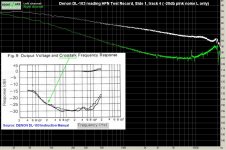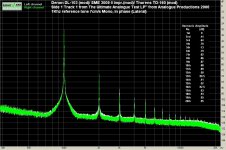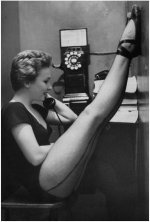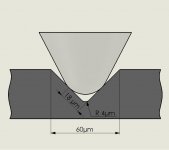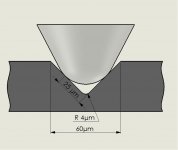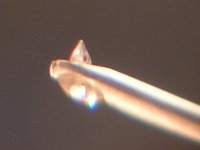To minimize TT/LP distortion up to a C- performance level you need to do these setup 'adjustments' before playing an LP:
http://www.vacuumstate.com/fileupload/GuruSetUp.pdf
THx-RNMarsh
http://www.vacuumstate.com/fileupload/GuruSetUp.pdf
THx-RNMarsh
Last edited:
Yes I do all these things before measuring. It's a time-consuming process, although after half a dozen times routine sets in and you can go faster.
But I also found that for instance the least distortion or best channel separation does not necessarily coincide with perfect VTA, to mention just one example. When you measure it is very well possible to find the best performance at, say, -0.5 degrees VTA.
Jan
But I also found that for instance the least distortion or best channel separation does not necessarily coincide with perfect VTA, to mention just one example. When you measure it is very well possible to find the best performance at, say, -0.5 degrees VTA.
Jan
John
According to the data sheet of my TT, it has an arm resonance at 8-9 Hz, and peaks at some 6-7 dB. Since my subsonic filter is first order, with -3 dB at 15 Hz, at the arm resonance point it should be at around -9 dB or so. I'd say that's a pretty close match, and on its own, I can't remember a single time some warp or something made my bass driver cones dance.
Frank
I never argued that low cost TTs could not sound good, Frank. I know for a fact that they can. In its time, for example, Thorens 160 TT was a reasonably priced TT many people bought and listened to for decades There were other good deals to be had, especially in the mid price range - for example, Telefunken had their model 650, which was their base and mechanics and Ortofon's AS212 (or 202, or some such) arm in a definitely above average package, Philips had a few excellent models, as did Parepetuum Ebner and so forth, and we haven't even reached a slew of UK made TTs by the likes or Ariston, Rega, Pink Triangle, etc. Not to even mention the Japanese, like Sansui's 212 model, a legend still alive today (just look at their second hand prices).
Just like regular audio - if someone put their mind down to it, much more than average could be done. Just as it is today, really no different. Low end gear was usually compromised by low end electronics, and especially the phono stages. You can easily see this frm the sheer number of phono eq/amp projects offered at the time. Locally, the DIY folks had a taste of that from a project done by Italy's premier audio magazine SUONO at the very end of the 70ies, a whopper even by today's standards, and man, that thing made some wonderful noises even with dirt cheap electronics. What almost out an end to this was the new marketing strategies of the audio companies, with their "structured portfolios, "product niches" and so forth.
These days, we see more or less the same thing by today's equivalents of phono stages, outboard add-on DACs. The Auddie model I bought (the "Real Time" DAC, with 8 parallel Philips 1543 DACs) is a good example, it surprised many an owner of cheap CD players by taking the signal from their SPDIF or optical outputs and kicking their players up a notch or two.
According to the data sheet of my TT, it has an arm resonance at 8-9 Hz, and peaks at some 6-7 dB. Since my subsonic filter is first order, with -3 dB at 15 Hz, at the arm resonance point it should be at around -9 dB or so. I'd say that's a pretty close match, and on its own, I can't remember a single time some warp or something made my bass driver cones dance.
Frank
I never argued that low cost TTs could not sound good, Frank. I know for a fact that they can. In its time, for example, Thorens 160 TT was a reasonably priced TT many people bought and listened to for decades There were other good deals to be had, especially in the mid price range - for example, Telefunken had their model 650, which was their base and mechanics and Ortofon's AS212 (or 202, or some such) arm in a definitely above average package, Philips had a few excellent models, as did Parepetuum Ebner and so forth, and we haven't even reached a slew of UK made TTs by the likes or Ariston, Rega, Pink Triangle, etc. Not to even mention the Japanese, like Sansui's 212 model, a legend still alive today (just look at their second hand prices).
Just like regular audio - if someone put their mind down to it, much more than average could be done. Just as it is today, really no different. Low end gear was usually compromised by low end electronics, and especially the phono stages. You can easily see this frm the sheer number of phono eq/amp projects offered at the time. Locally, the DIY folks had a taste of that from a project done by Italy's premier audio magazine SUONO at the very end of the 70ies, a whopper even by today's standards, and man, that thing made some wonderful noises even with dirt cheap electronics. What almost out an end to this was the new marketing strategies of the audio companies, with their "structured portfolios, "product niches" and so forth.
These days, we see more or less the same thing by today's equivalents of phono stages, outboard add-on DACs. The Auddie model I bought (the "Real Time" DAC, with 8 parallel Philips 1543 DACs) is a good example, it surprised many an owner of cheap CD players by taking the signal from their SPDIF or optical outputs and kicking their players up a notch or two.
Last edited:
In my view, the greatest stumbling block in low and mid priced TTs was the selection of an appropirate cartridge. Too many people failed to realize that you can't pair arms and cartridges on basis of price alone, There was the matter of mass, compliance, output-input matching with the phono stage, and most had never caught on the part of capacitance loading the cartridge. Few bothered to read the supplied literature to find out whether their cartridge needed extra capacitance, as many Ortofon cartridges did if you didn't want them to peak in the 15-20 kHz range. And mistakes here tend to add up, messing up the sound.
Yes I really should do that.
But where do I find a laser TT.
Jan
I'll make a bold prediction the grooves as cut, would make 0.1% if very lucky.
I'll make a bold prediction the grooves as cut, would make 0.1% if very lucky.
Mostly third?
Of course, all this ignores the vinyl compliance...
Mostly third?
Of course, all this ignores the vinyl compliance...
Not sure, I wonder how symmetrical the chiseling is. I just can't see this mechanical contrivance performing better than that.
Mine is off of a local crowd-funded product U-Turn Audio
Congratulations for your new TT
Straight arm + unipivot + no antiskating was a good design decision. (if you can mod the shell for adjustable to zero cartridge offset angle?)
No it is an
JC doesn’t want to know.
And don't get me started about 40dB max channel separation and THD nobody would accept in his electronics. See attached for a typical sample.
Add to this that this 40dB does not hold across the audio band (at least, channel separation is not a cardinal spec)
Jan, any chance you can borrow some time on the laser TT? I would love to put to bed the doubt that the tests tones actually are/aren't distorted themselves. For 30yr. no table/arm/cart combo has ever bettered ~-40dB levels for me.
I wish Jan will do this.
My assumption is that at least 1/3 from the HD we read back is already in the grooves (and this for cautiously cut test records).
These were remarkably good for a 1900 technology, remarkably bad for a 1985 technology.
TT/vinyl comes from the past. The combo does it’s job as it did back then.
It is not doing well with measurements anymore but like other old technologies, is still pleasing our senses. 😉
George
Attachments
Congratulations for your new TT
Straight arm + unipivot + no antiskating was a good design decision. (if you can mod the shell for adjustable to zero cartridge offset angle?)
Unmoded it took the tracking test as far as my Sumiko arm did. Right now I don't have the time or want to invest in a whole new LP set up but I needed something to take data for my article. All it really needs is to be properly grounded and made diff out, doable with no soldering. And it's lime green to go with my new office walls. 🙂
I assume the Denon does not have the spherical stylus?
Last edited:
IME that law can largely be sidestepped in audio - convincing sound, or close to it can be achieved for remarkably little cost, everything beyond is icing on the cake. Mainly, higher competent SPLs, and better rendition of low bass are gained with money, prudently spent; also, "purity" of very simple, audiophile style recordings is improved.
Yes, yes indeed. Just go for those PC speakers and u can get top flight sound no problem. 😀
Unmoded it took the tracking test as far as my Sumiko arm did.
Good. Which tracking test did you run?
I assume the Denon does not have the spherical stylus?
17 µm spherical tip (nude diamond).
A bit more distorting (in theory) due to pinch-off compared to a line contact profile but otherwise, it is the proper tip shape and size for the vinyl records I am interested in (O.K. I am often in need for a 25um spherical mono cartridge)
George
Attachments
Good. Which tracking test did you run?
17 µm spherical tip (nude diamond).
A bit more distorting (in theory) due to pinch-off compared to a line contact profile but otherwise, it is the proper tip shape and size for the vinyl records I am interested in (O.K. I am often in need for a 25um spherical mono cartridge)
George
I have an old Telarc Omnidisk that ramps up a two tone to (they claim) beyond where any cart can track.
I'm surprised, I would love to see actual data to support claims of line contact performance. Have you found better/worse test disks for the standard 1k THD tracks.
One of these awful dogs who prefer digital because he can play with the remote control ?My dog mercifully relieved me of it by knocking the little plate of tiny set screws and miniature bearings into the carpet.
One of these awful dogs who prefer digital because he can play with the remote control ?
He's actually mostly deaf, but he does sit on the remote at times.
The Denon DL 103 Standard Stereo Original has a spheric tip with radius 17um, but low compliance, need heavy arm.
All *Special* DL 103 have some elliptic styli, different compliance and other things different..
All *Special* DL 103 have some elliptic styli, different compliance and other things different..
I have an old Telarc Omnidisk that ramps up a two tone to (they claim) beyond where any cart can track.
Disk I, Side 2, track 9?
TELARC LPs - Telarc Omnidisc
I'm surprised, I would love to see actual data to support claims of line contact performance. Have you found better/worse test disks for the standard 1k THD tracks.
I only have the HFN Test LP and the “The Ultimate Analog Test LP” from Analog Productions
I find the second of a bit better technical quality. The first has more useful testing tracks.
I think this one is a very good test record for trackability.
Clearaudio Trackability Test Vinyl LP at Music Direct
I find it imperative for a technical test record to specify the details of each track in clear terms and in eligible, traceable measurement units.
For example an unspecified “0 dB level” can mean a lot of different modulation levels.
The same output level from stereo & monaural grooves with stereo cartridge: stereo one-channel recorded velocity towards 45degrees = monaural velocity/√2.
Different Standards. , “0 dB level” is :
-Following RIAA/IEC, “0 dB level”is 8cm/s for stereophonic records, 10cm/s for monophonic records and 12cm/s for MaxiSingle.
-DIN 45537 (1962) Monaural Records: peak 10cm/s at 1000Hz with the reservation that its value is to be approved internationally. Later 10cm/s for monaural 1kHz test tone was replaced by 11.3cm/s. (8cm/s * √2)
-DIN 45547 (1981) Stereophonic Records: effective 5.6cm/s (=peak 8cm/s) at 1000Hz
Therefore, the optimum would be to express the amplitude of groove modulation in microns (peak) and from this to calculate the modulation velocity.
Theoretical/geometrical value of velocity: Peak Velocity for sinusoidal modulation = amplitude or displacement of modulation from centre (0 to peak)*2pi*frequency.
So for this ClearAudio trackability test disk 333Hz tracks:
50 micron=10.46cm/s (peak)
60 micron=12.55cm/s
70 micron=14.64cm/s
80 micron=16.73cm/s
90 micron=18.82cm/s
100 micron=20.91cm/s
Of course I want to know. I don't need these jibes.
Jan and others have repeatedly provided data, links and measurements in this thread. Sum-up: TT/vinyl does not measure well.
If you say “I don’t agree with you Jan” is like ignoring all these contributions.
Nevertheless, Jan politely asked for your relevant data.
George
Last edited:
Disk I, Side 2, track 9?
TELARC LPs - Telarc Omnidisc
Yes, there is an extensive liner note with all the specs on each track. I should post a picture of the canons from 1812 at some ridiculous level, after the first time I tried it I became afraid of bent cantilevers. 🙂
I see Clearaudio has a cartridge "break-in" LP also.
Last edited:
Yes, there is an extensive liner note with all the specs on each track. I should post a picture of the canons from 1812 at some ridiculous level, after the first time I tried it I became afraid of bent cantilevers. 🙂
I got a mint copy of the Telarc 1812 with an ebay grab bag of records, about 100 records for £30. Memsahib was not happy with me... Was happy to note that my setup tracked it with no drama. Does anyone know what the peak velocity is on that disk?
Speaking strictly for myself, the fact that I am aware that my LP and cartridge are producing lots of THD and IM (by electronic gear standards) in no way lessens my pleasure when spinning my favorite LPs, even if I have most of them on a CD as well (from the factory/studio/publisher).
- Status
- Not open for further replies.
- Home
- Member Areas
- The Lounge
- John Curl's Blowtorch preamplifier part II
